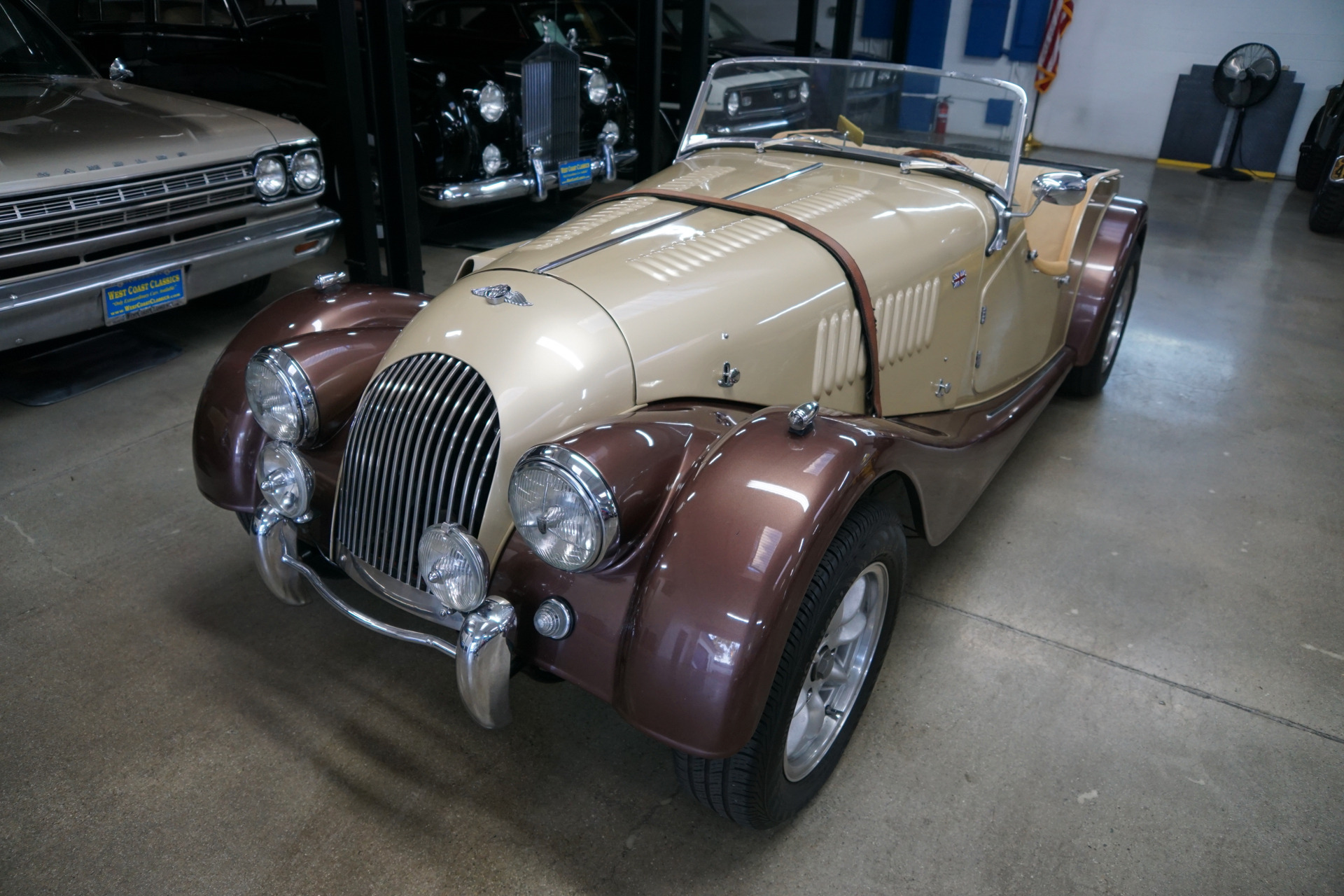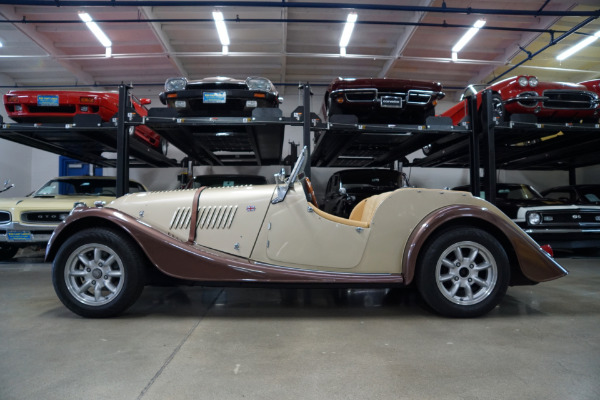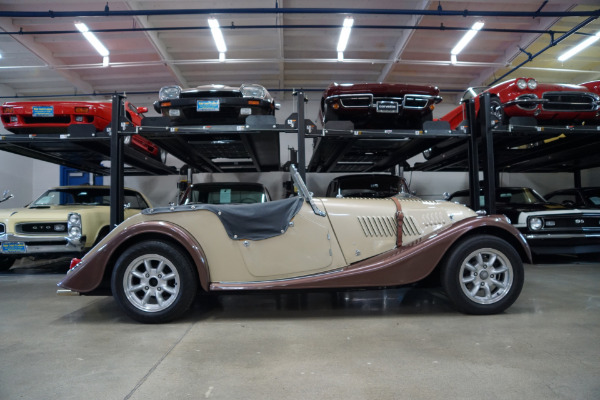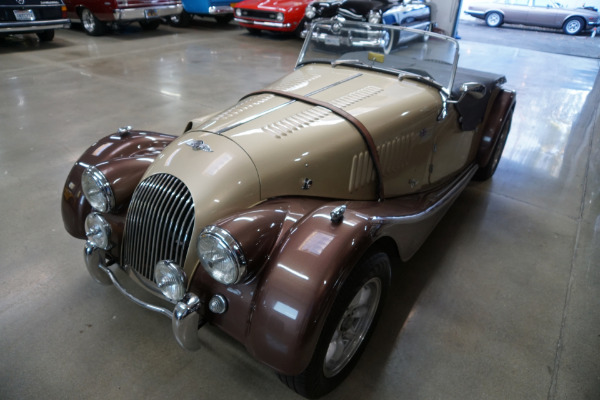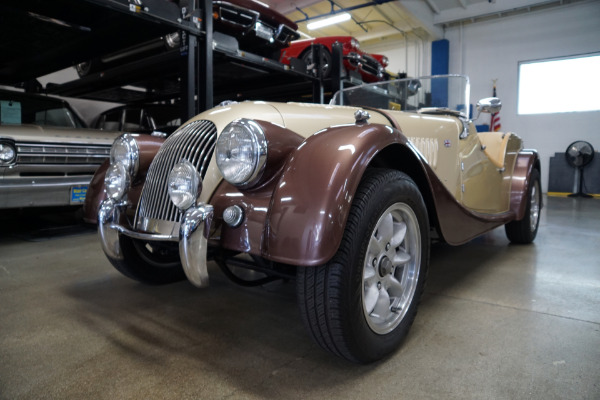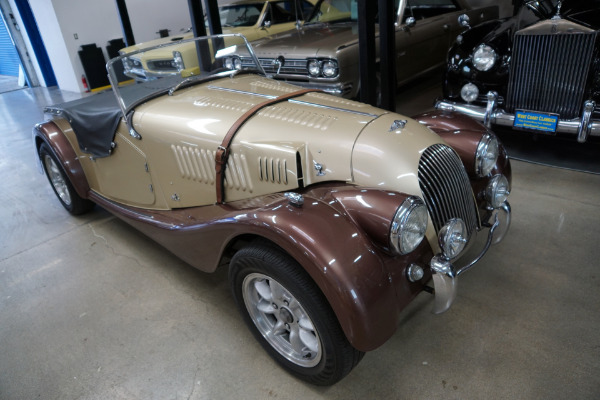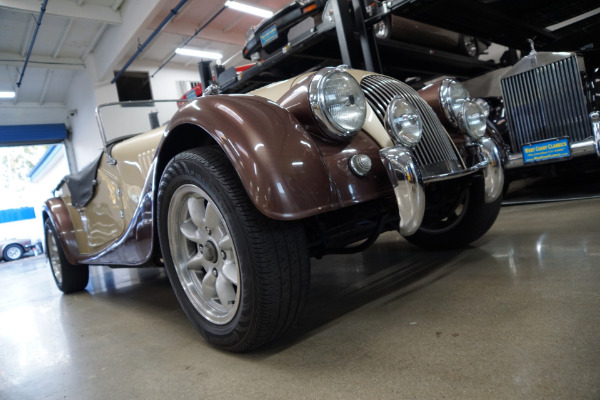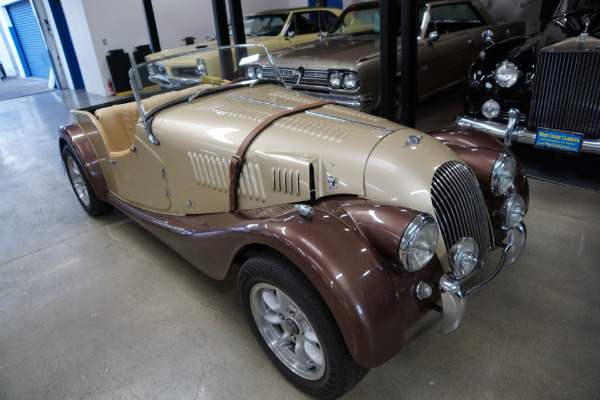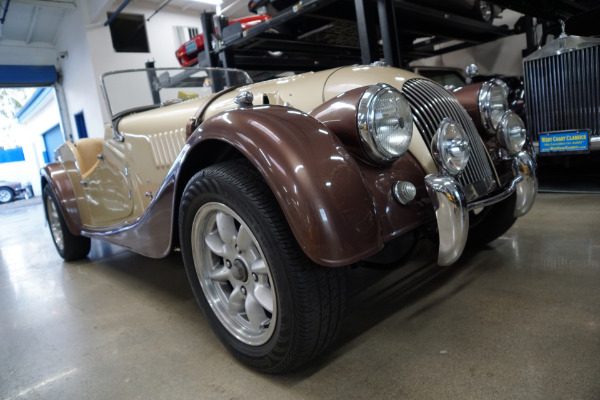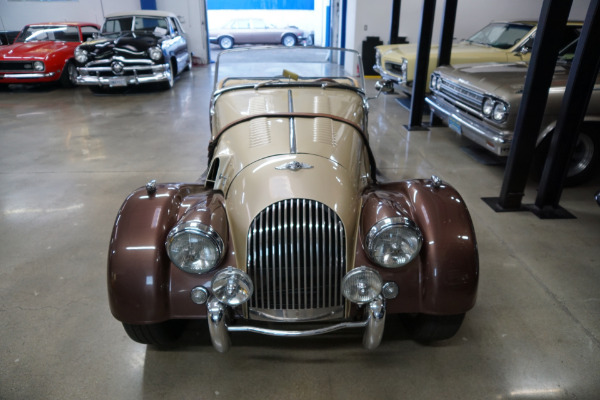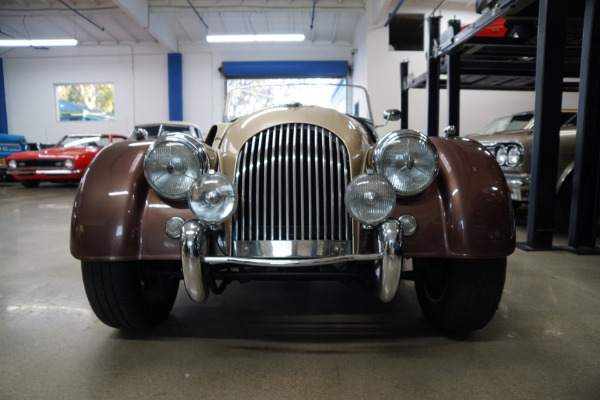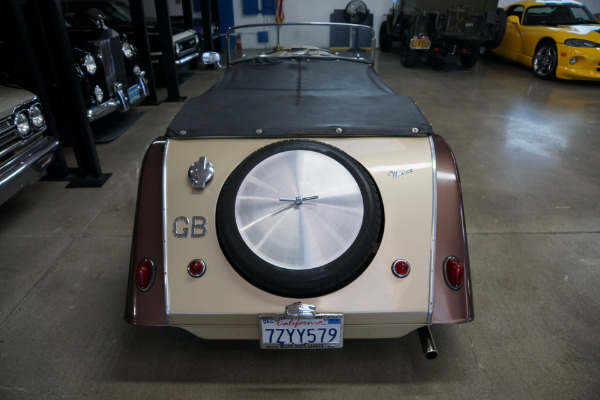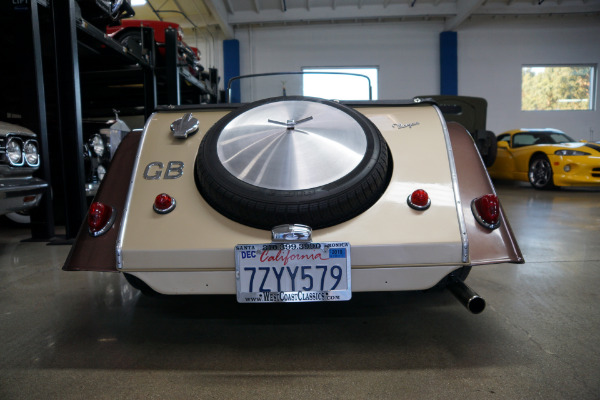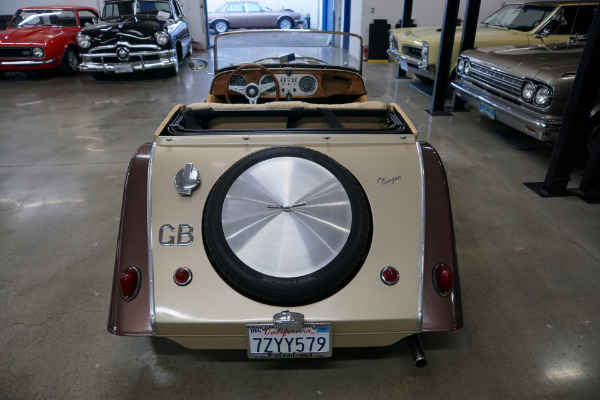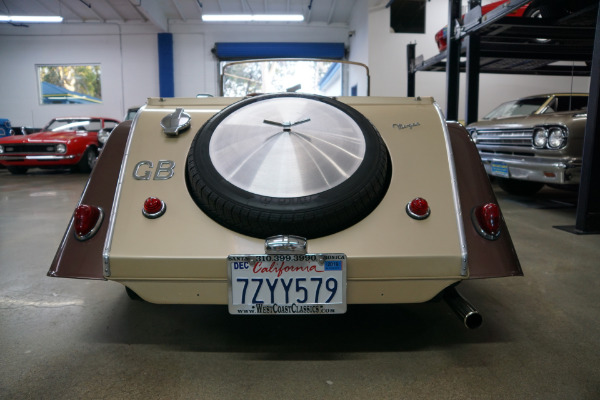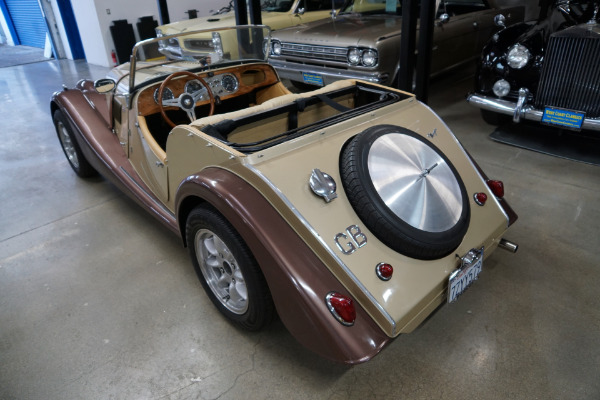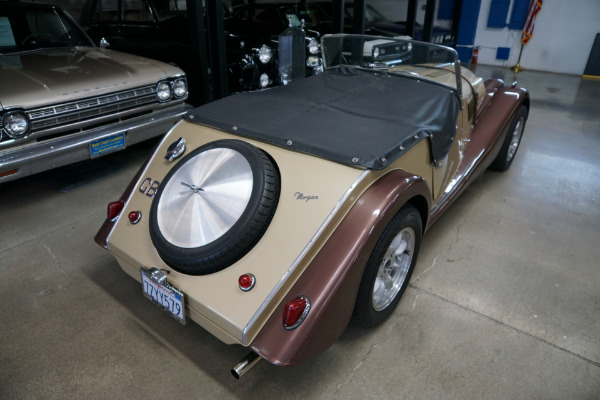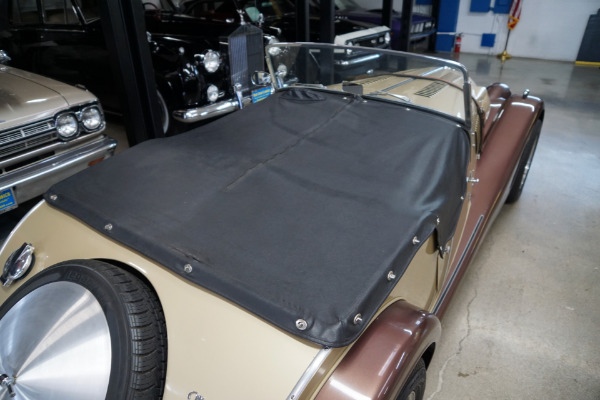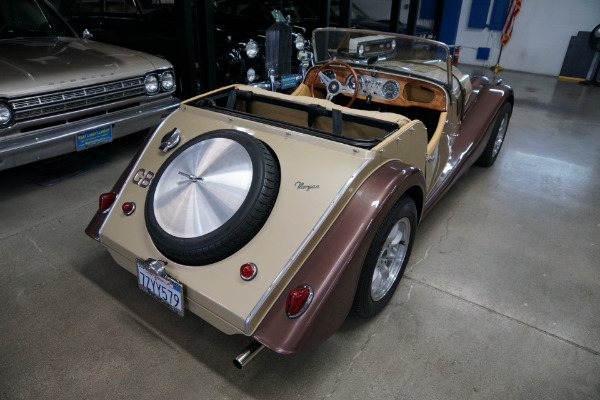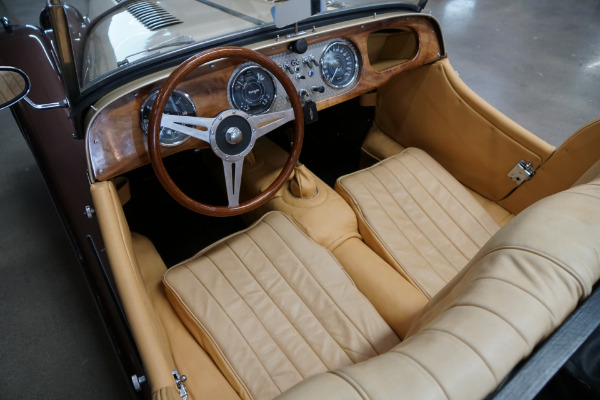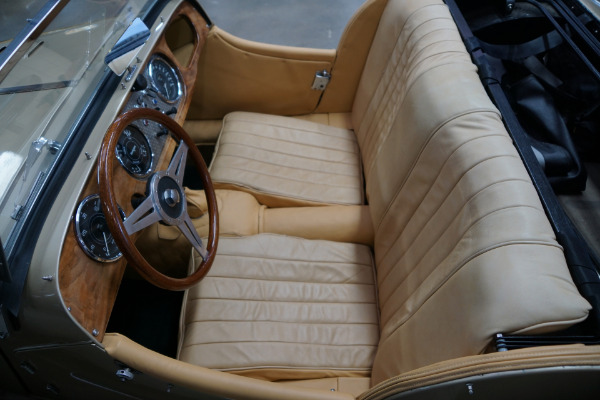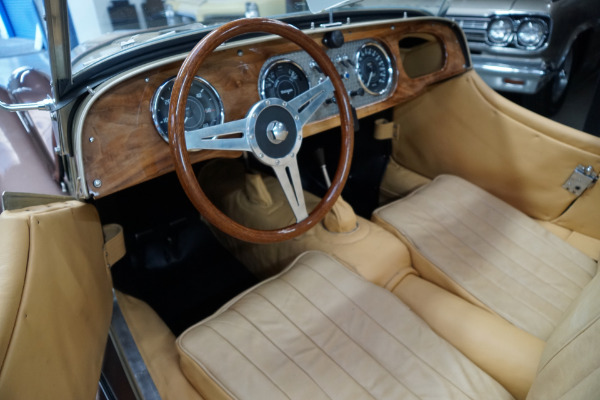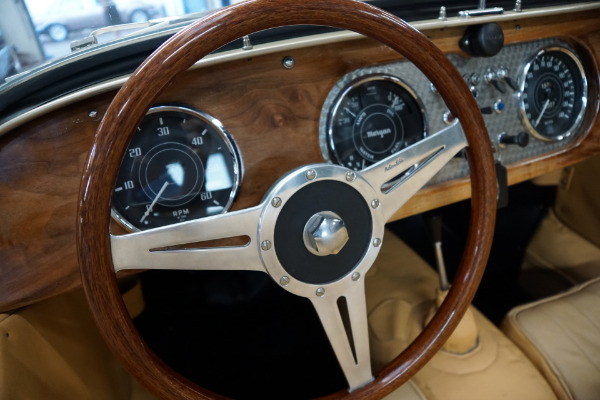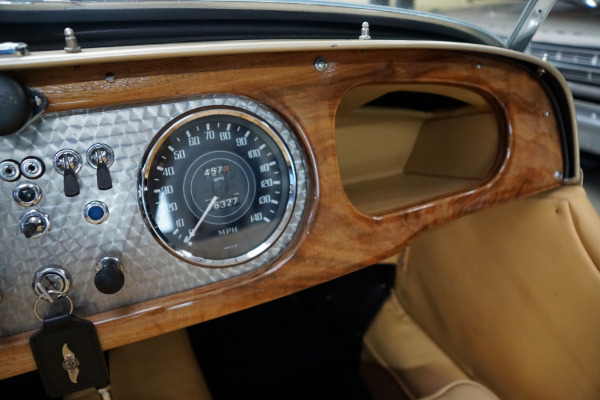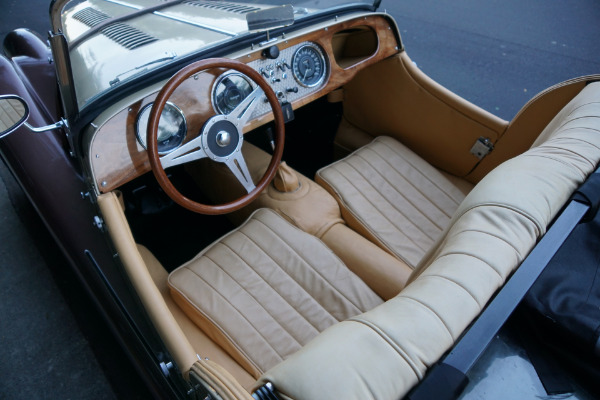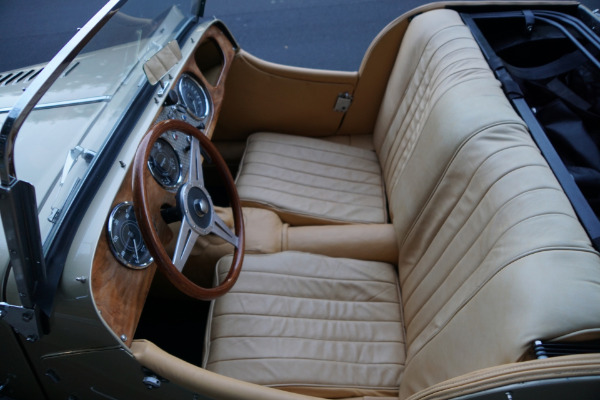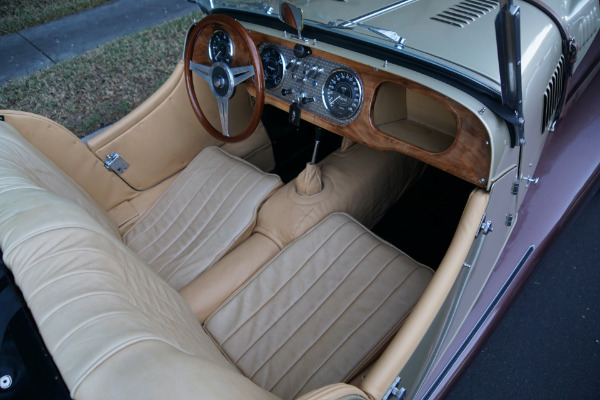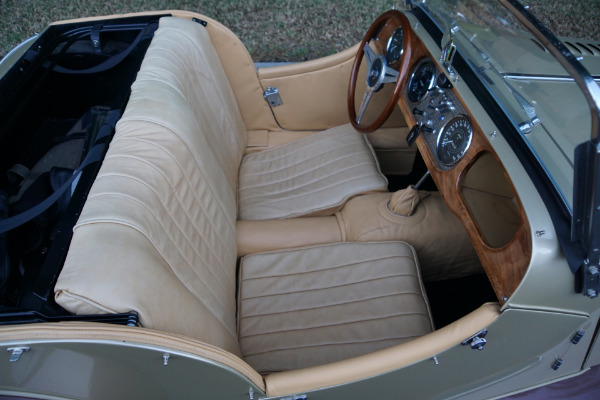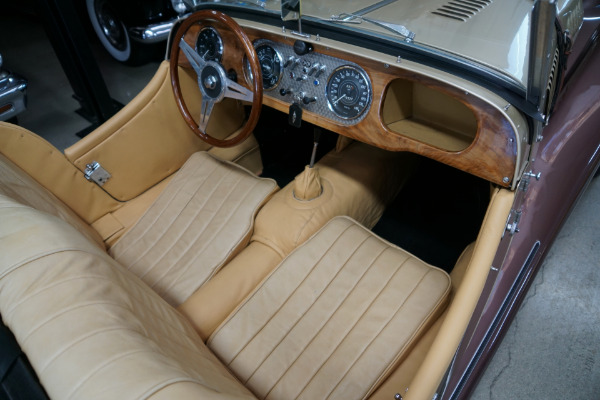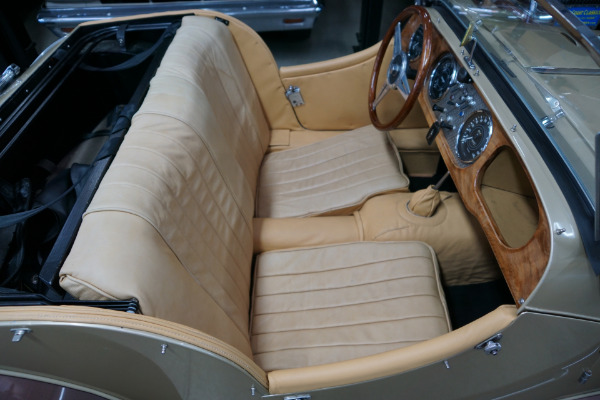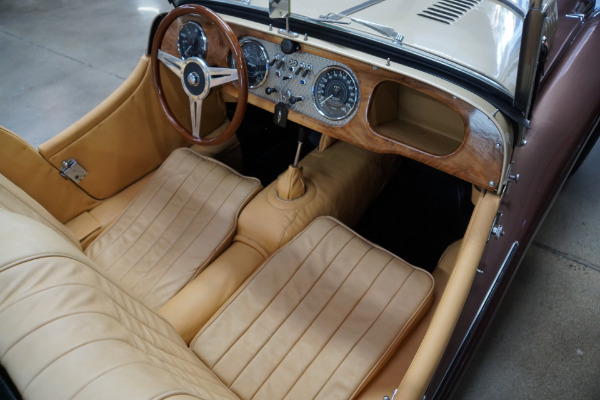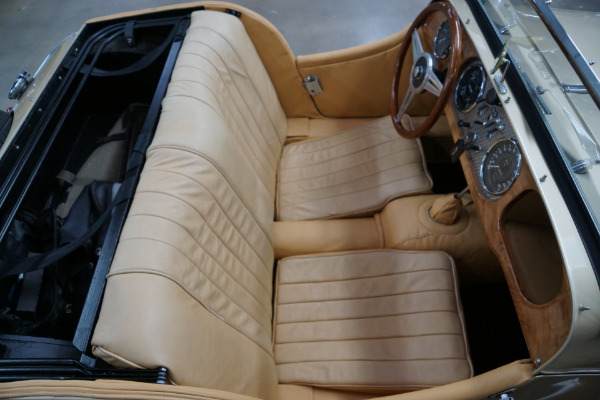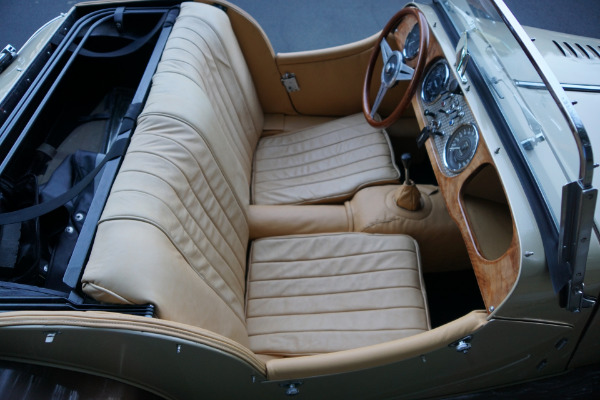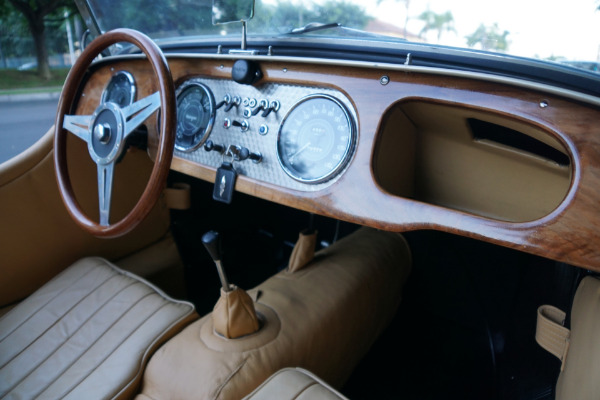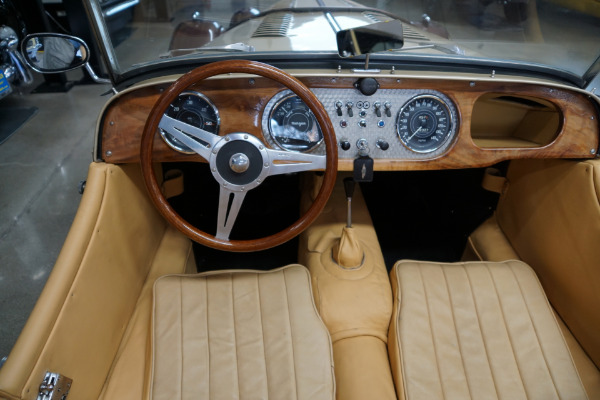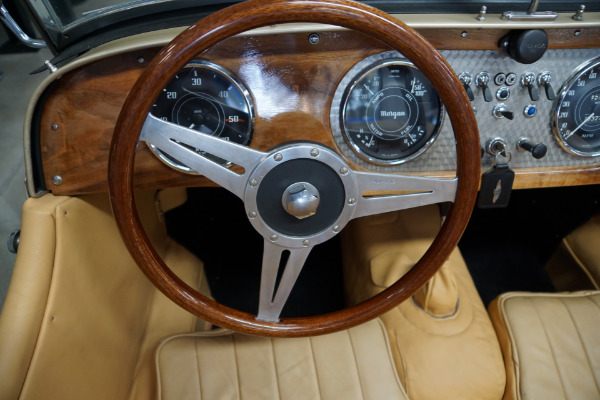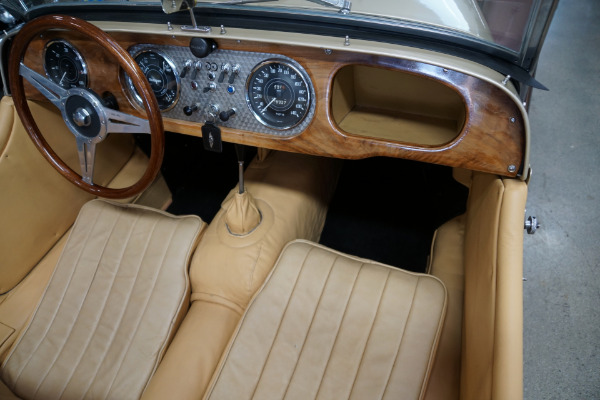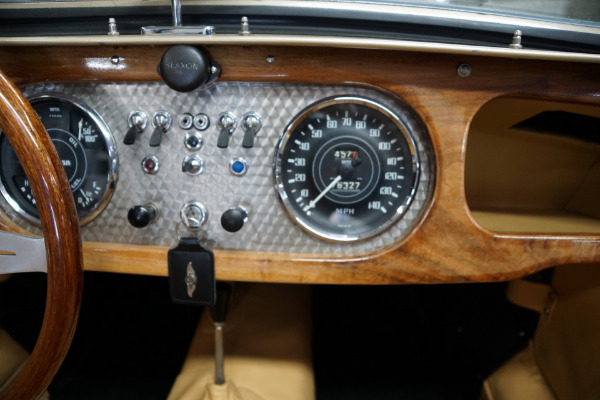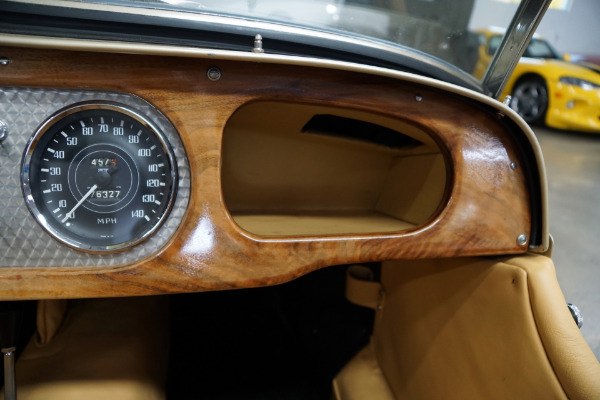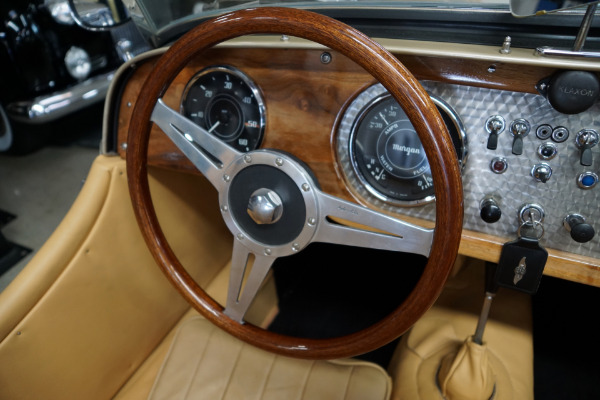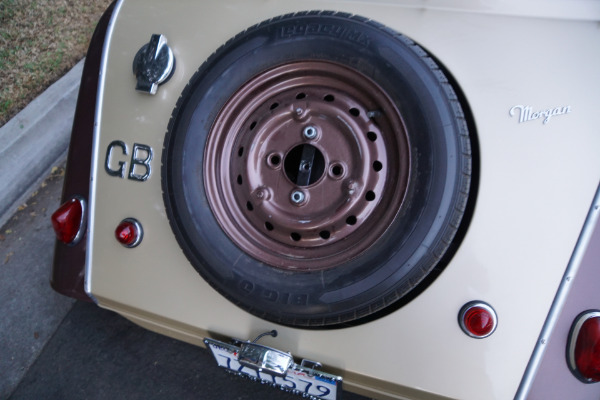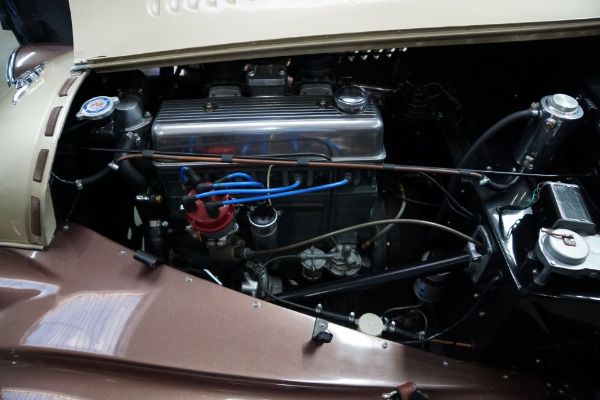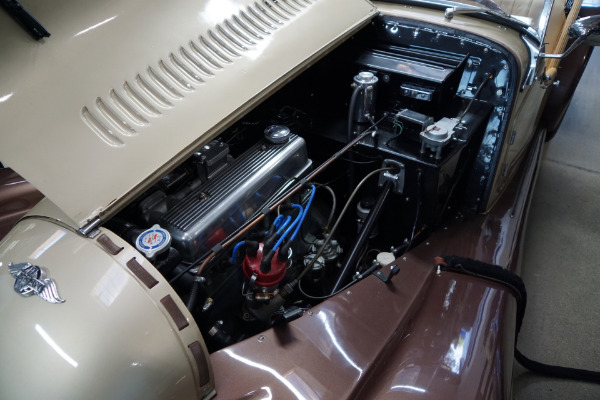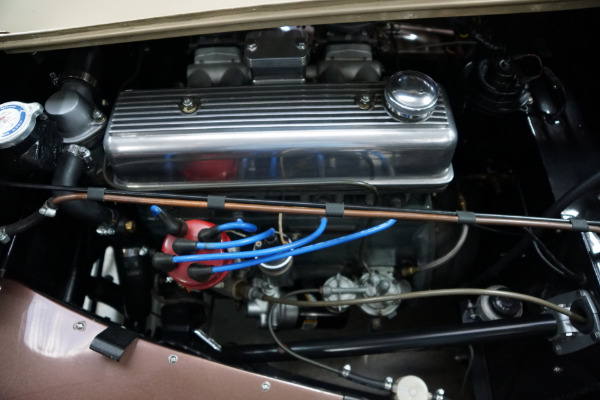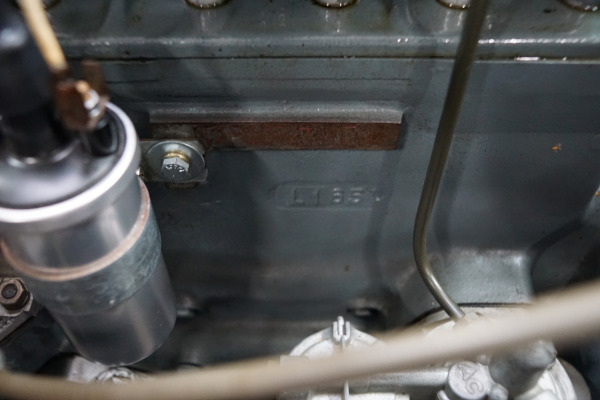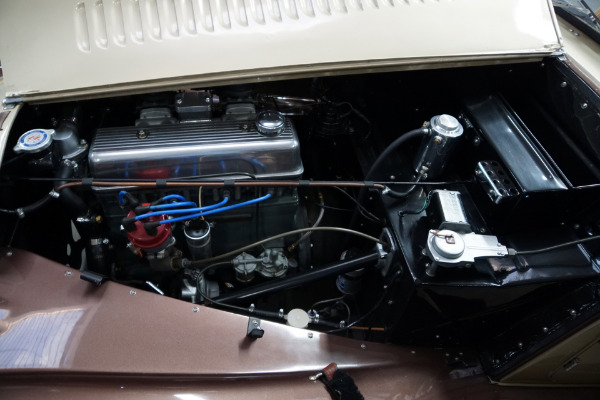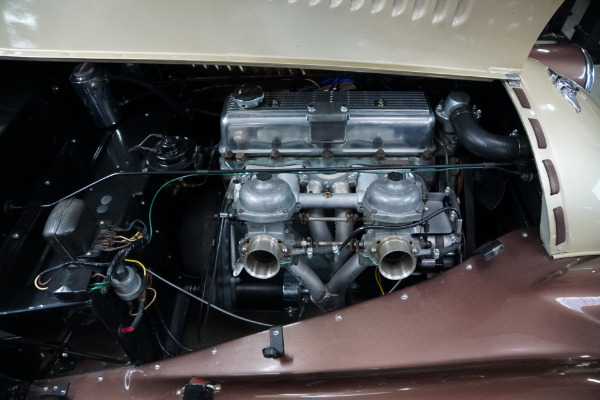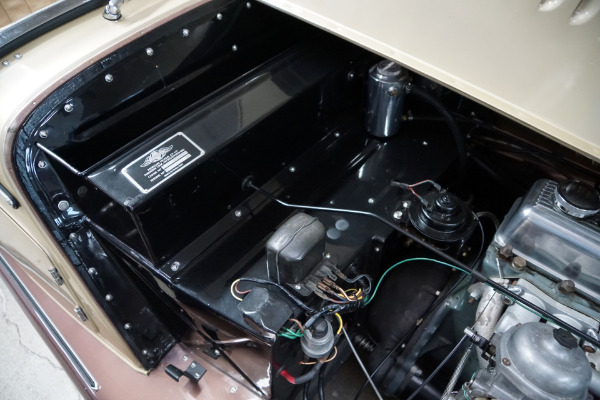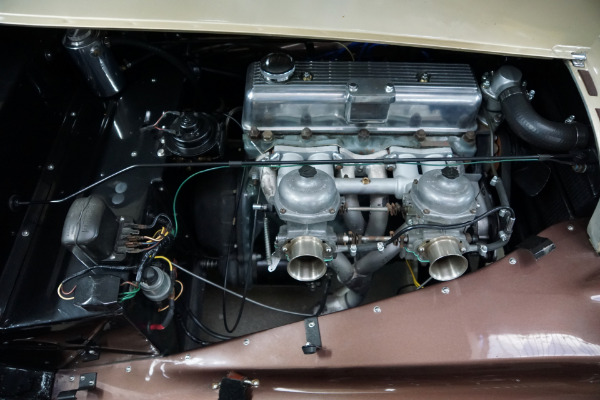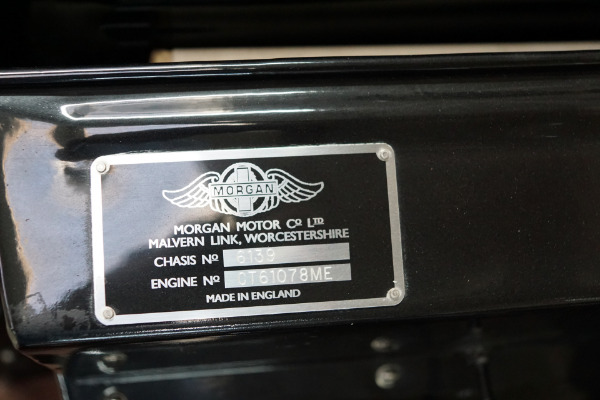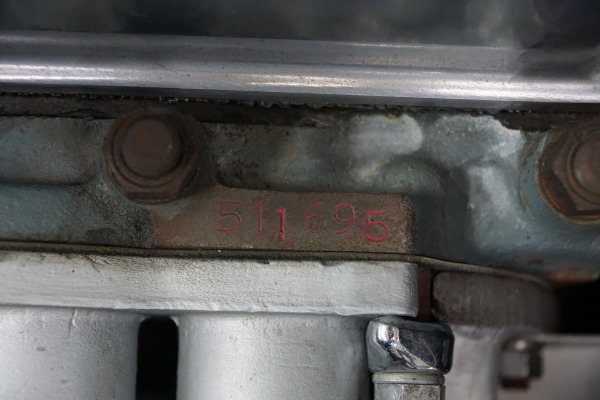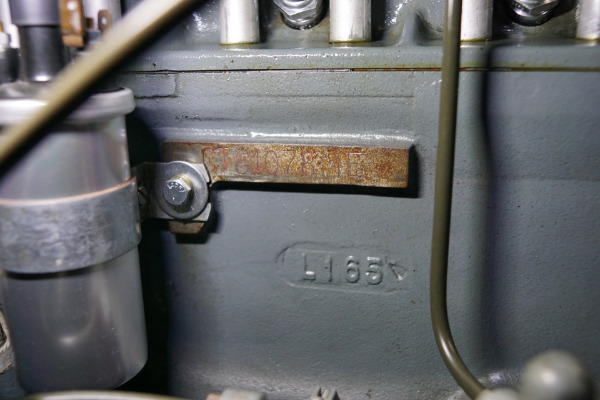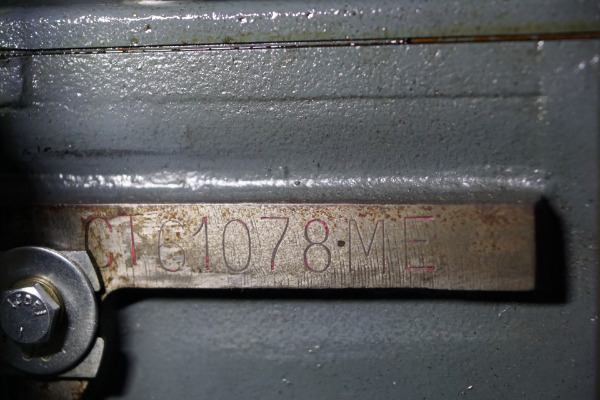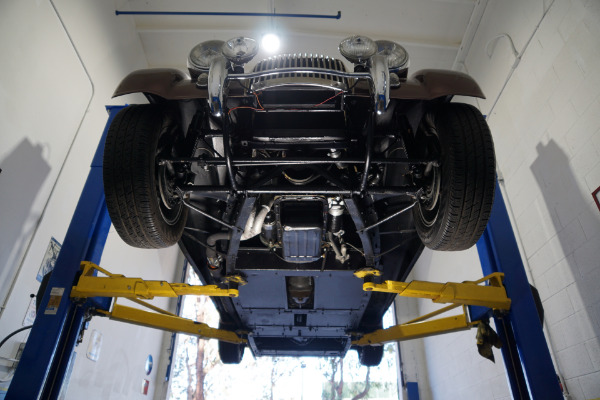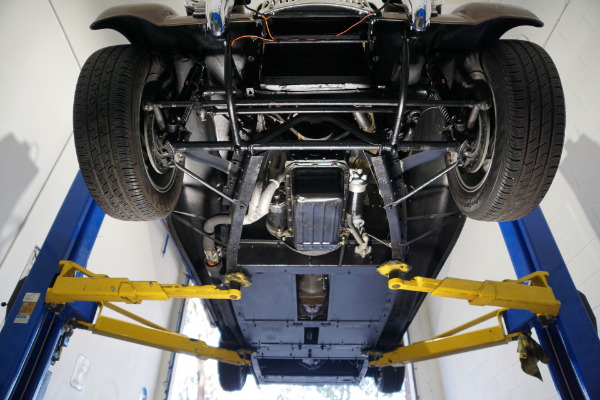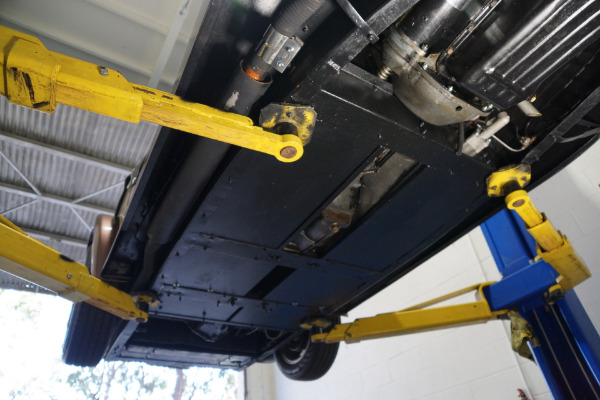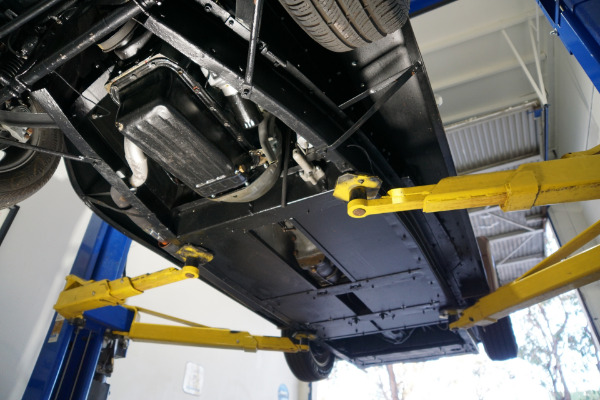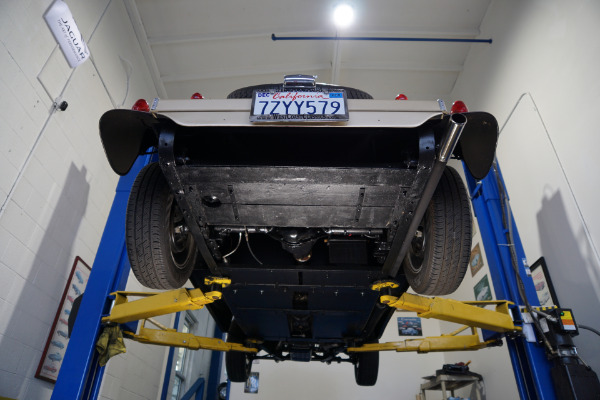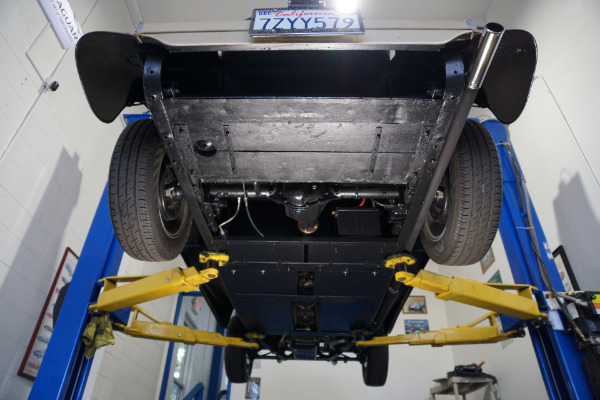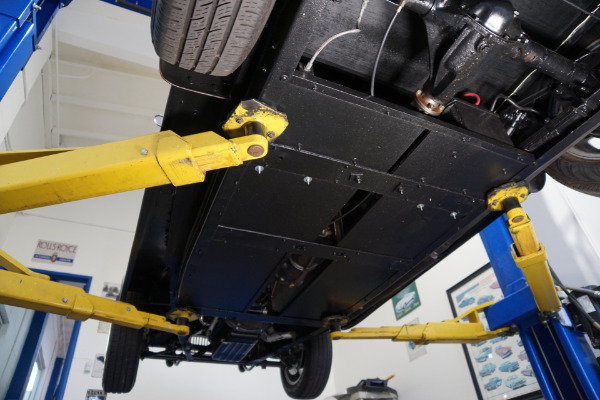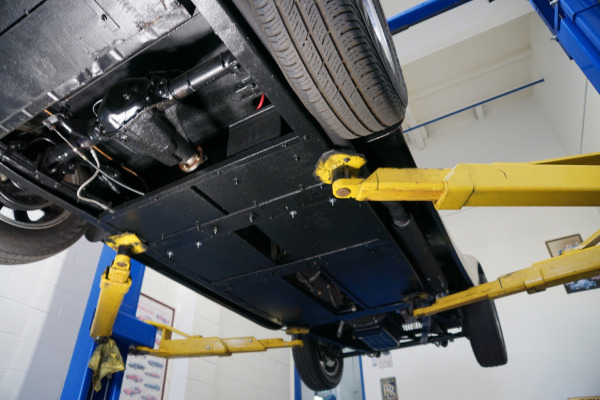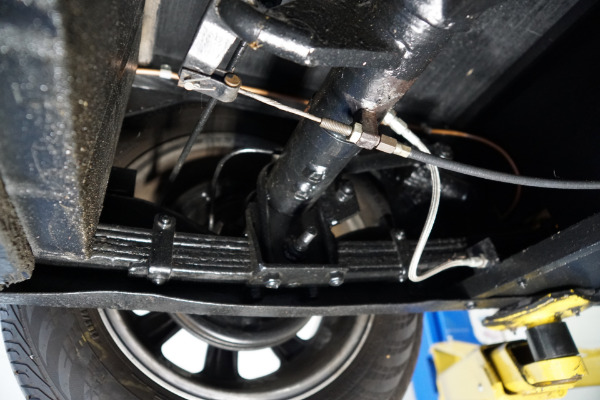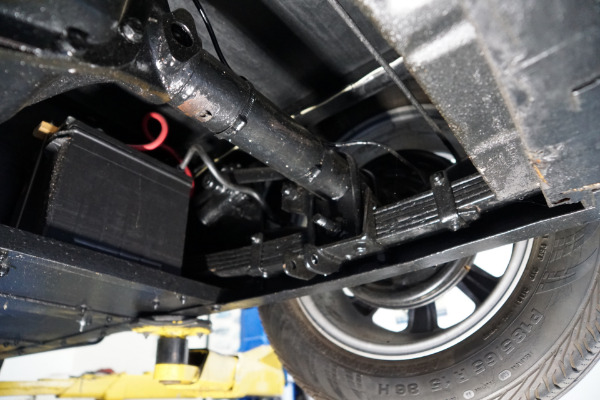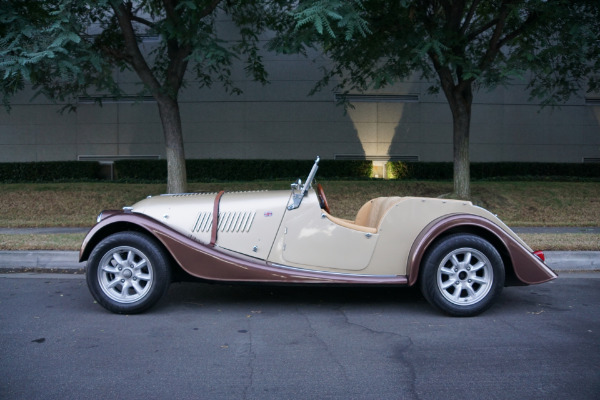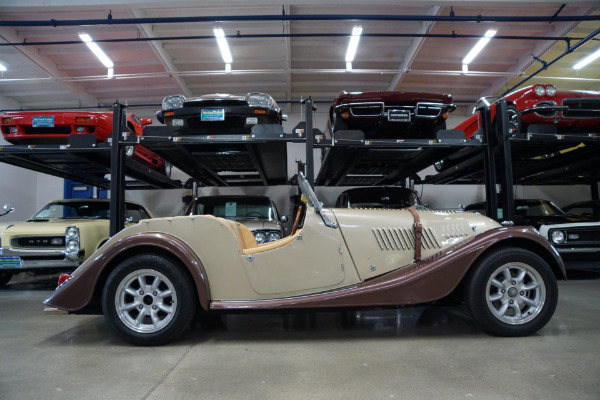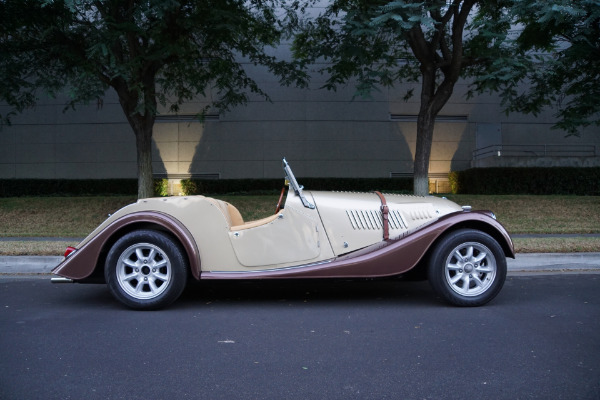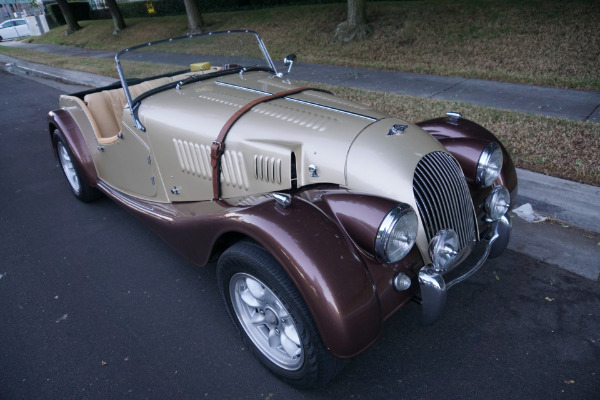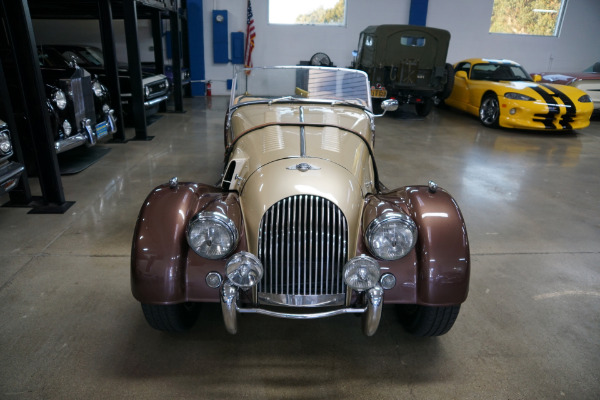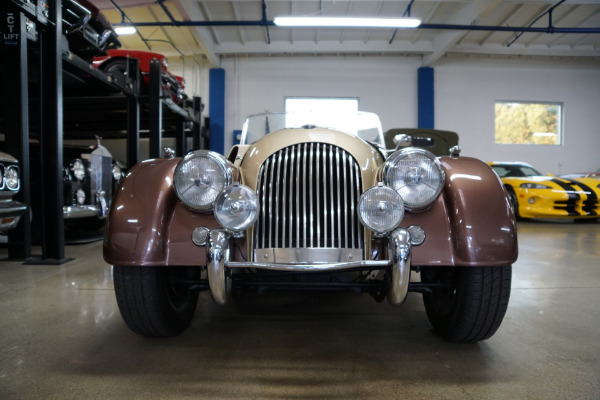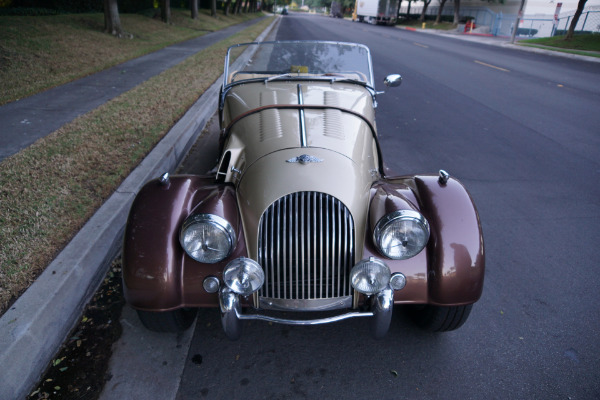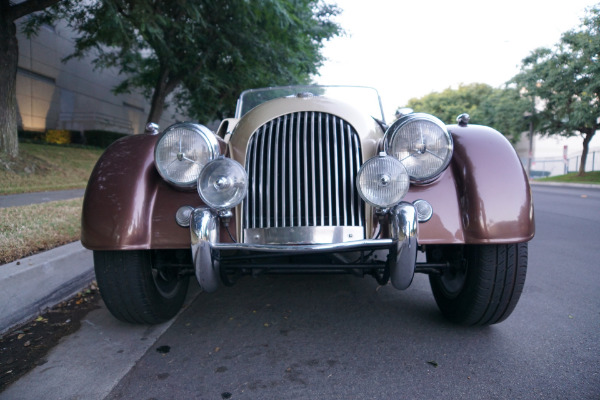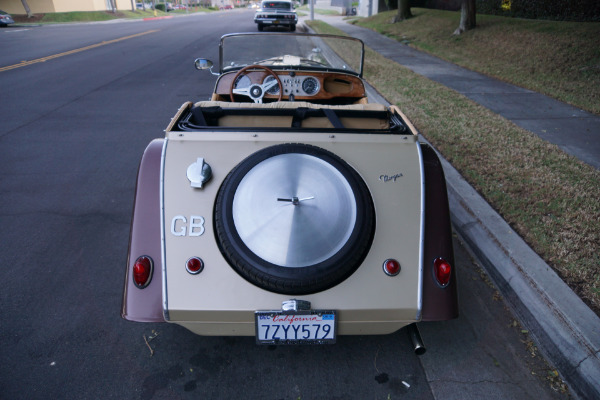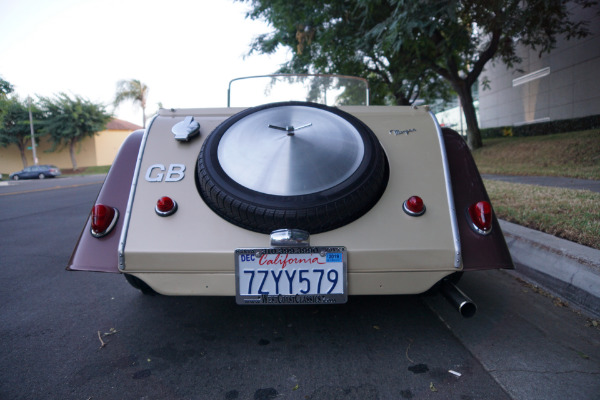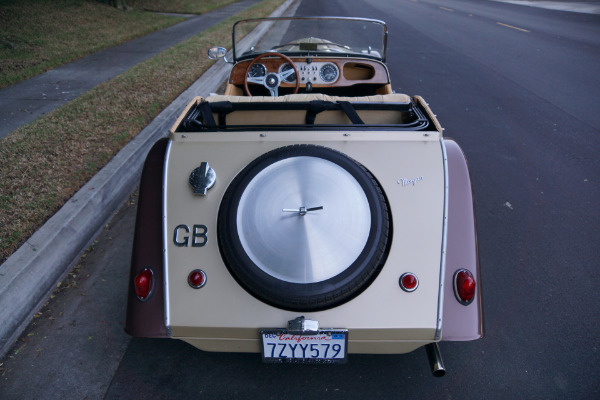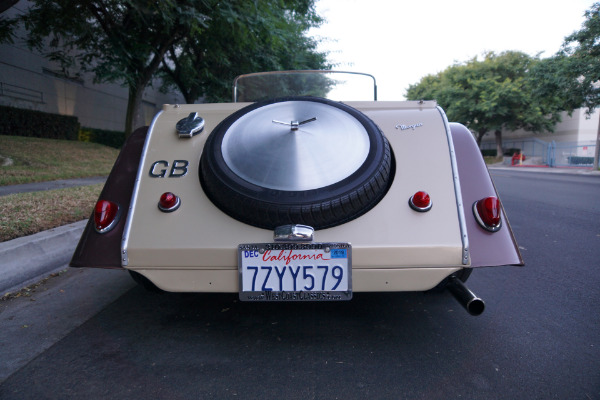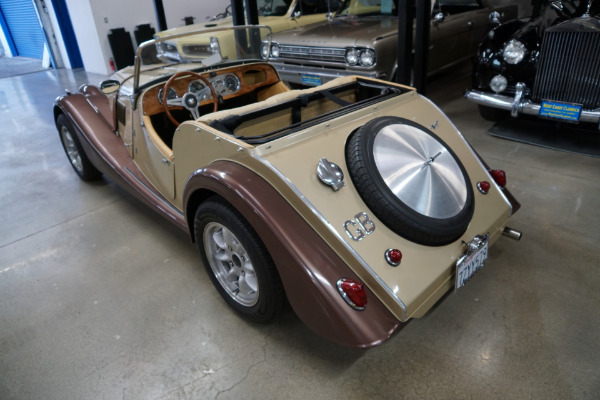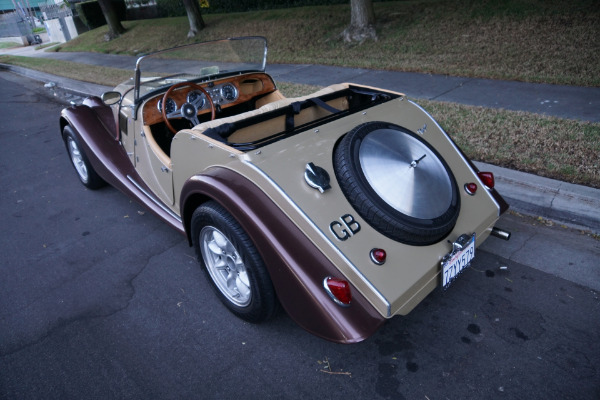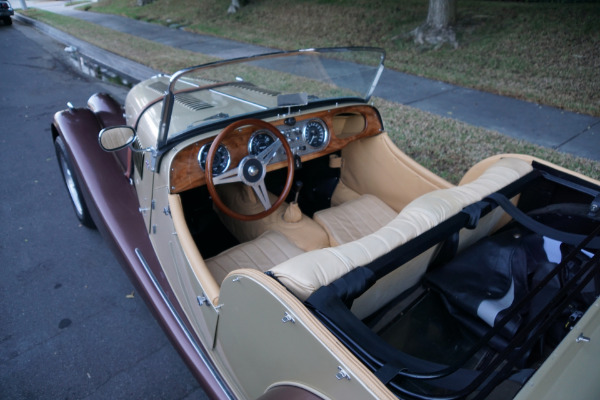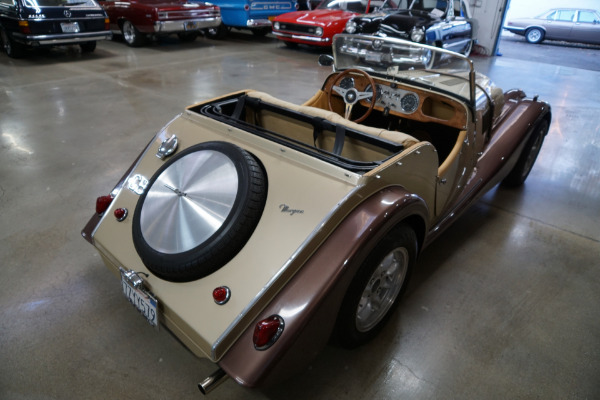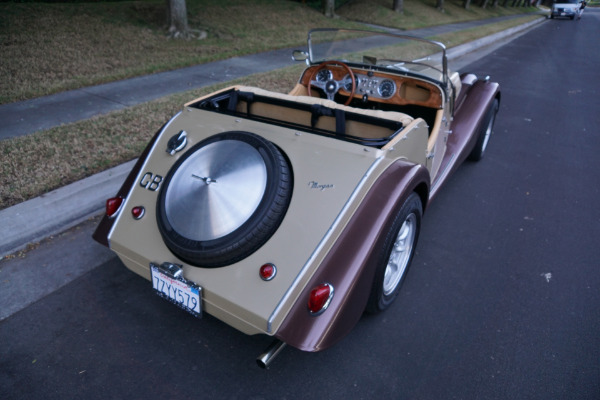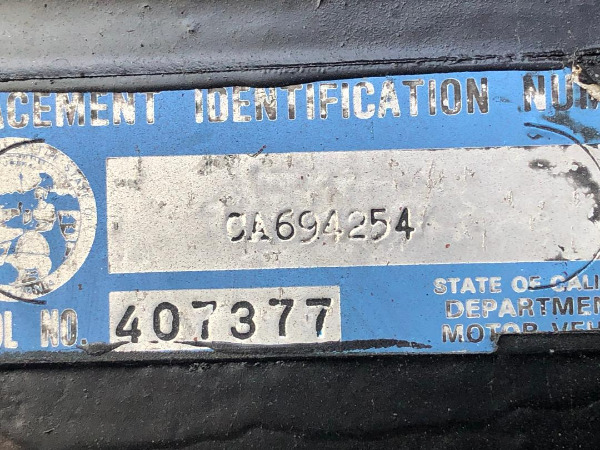West Coast Classics are proud to present a superb and great daily driving and a recently restored example of this 1968 Morgan Plus 4 two seater suicide door Roadster Convertible with it's original matching #'s CT TR4 2138cc 4 cylinder engine with twin SU carbs, chassis # 6139, side windows, soft top frame and tonneau cover.
This is a very special Morgan. Just won 1st in class at Mogwest 2019. Drove 600 miles round-trip with no issues. It was owned by an original member and past President of the Morgan + 4 club of southern California who has raced, restored and shown countless Morgans. This is a CA car with a recently completed restoration. The restoration was started by another CA Morgan club member a few years ago and then the car was finished in 2018 by Derek Willburn, with his mother Barbara doing the interior. You might also want to check out this short feature on Derek, Man of Morgan https://www.youtube.com/watch?v=DdsvbrrWM1A
As is evident from the photos, this Morgan sparkles inside and out. The metal and wood are in excellent condition, as is the interior and running gear. The engine number on the block matches the ID plate near the firewall. The TR engine runs super strong. Derek opened up the engine and checked the rod bearings, etc. and all was in good order. Derek also rebuilt the dual Stromberg carburetors. The choke works like it should, and the engine fires up easily and settles into a smooth idle in no time at all. The engine is very healthy with a lot of power, and based on our experience with Morgan's, the engine was likely gently massaged with a hotter camshaft and perhaps other internal upgrades installed in the past. Oil pressure is strong. Headers are also fitted allowing the engine to breathe better. Her brakes use cross-drilled and vented rotors, and needless to say her braking ability inspires confidence. Steering and suspension are spot on, with nimble and precise handling. You will notice that lightweight Panasport 15 x 6 racing wheels and 185/65 Continental tires with fresh tread are installed, offering a wider track and even stronger handling than stock. Grab the new Moto Lita wooden steering wheel and toss her through the corners of your favorite road. You won't be able to wipe the grin from your face. The 4 speed Moss gearbox is among the best we've driven, allowing tight and smooth shifts through all gears. The clutch is adjusted perfectly, with just the proper amount of pressure needed to engage the pedal. All lighting and instrumentation works as it should. The gauges appear as new, with fresh and crisp faces and trim. New leather upholstery covers the seats and appropriate panels. New rubber mats line the floors and footwells, with new carpeting behind the seats.
Side curtains in fair condition are also included, and top bows are installed yet there is no top. A tonneau cover is also included. Note too the custom fabricated badge bar, as well as the aluminum spare tire cover. The tire cover was custom made locally by Moon. The spare wheel is an original Morgan 15-inch disc painted to match the body color. Also, there are holes already drilled if the next owner would like to fit Brooklands aero type windscreens. The engine bay and undercarriage sparkle just as much as the exterior.
This is obviously one rare and highly desirable classic British sports car - a beautiful and wonderful driving example of the last year for the legendary Triumph powered Plus 4 - an obviously always garaged example that was lovingly restored as necessary and which is showing only very minor signs of its age anywhere!
The original Triumph 2,138cc engine purrs quietly under the hood and the Moss 4 speed manual transmission shifts smoothly through the gears - an absolute pleasure to drive! The car has 4 mag wheels, ventilated disc brakes, exhaust headers and boasts it's original matching #'s engine. Please note that the car will need a canvas top for it's soft top frame to complete the soft top but does still have its original side curtains, full weather tonneau cover and spare wheel.
The Morgan Motor Company is a British motor car manufacturer that was founded in 1910 by Henry Frederick Stanley Morgan and based in Malvern Link, an area of Malvern, Worcestershire. Morgan originally made it's name building three wheel tricycles and did not make it's first four wheeled sports car until 1936 and Morgan cars still today produce some 850 cars per year, all assembled by hand, still in the same fashion of the original 1930's British sports car! The waiting list for a car is approximately six months, and has sometimes been as long as ten years. The bodystyle has changed little for decades. H.F.S. Morgan quit the Great Western Railway in 1904 and co-founded a motor sales and servicing garage in Malvern Link.
In 1909 he designed and built a car for his own use. Previously he developed the first independent front suspension in the engineering shop of Malvern College. He began production a year later and the company prospered. Production of his legendary three wheelers approached 1000 by WW1 and quickly resumed with both racing and touring models. Morgan's first four wheeler came in 1936 with three wheelers eventually phased out in 1952. Morgan continued to run the company until he died at age 77 in 1959. Peter Morgan, son of HFS, ran the company until a few years before his death in 2003 when he was replaced as chairman by Alan Garnett, a non-family director, from 2003 to 2006. After Garnett's resignation, a four-man management team was set up. Charles Morgan (son of Peter), helped made up the new management team, and in 2010 was named managing director. In January, 2013, Morgan was removed as managing director, replaced by another director, but continued as strategy director until October 2013 when he was then removed both as an employee and member of the board of directors. This marked the end of over 100 years of Morgan family ownership.
Morgan cars are unusual because wood has been used in their construction for a century, and is still used in the 21st century for framing the body shell. A visitor center and museum in Malvern, England have exhibits about the company's history from Edwardian times until the present day, developments in automobile technology, and a display of automobiles. There are also guided tours of the factory. Those who jest that Morgan automobiles have evolved at the same rate as the first fish that crawled out of the sea have never taken the time to study the iconic Plus 4. Not only did this model experience a number of notable visible changes in its 19 years of production, it used variants of five engines, each improving performance still further. The Plus 4 was Morgans premium sports car until being supplanted by the hot rod Plus 8, and thanks to its simple construction, excellent restoration parts supply and devoted enthusiast following, it remains one of the most highly sought models in this English firms 103-year history.
Whilst its true that while the Plus 4 that debuted at the fall 1950 Earls Court Motor Show didnt look much different from Morgans supplanted pre-war 4/4 which it replaced but the new model featured a number of improvements. The Plus in this models name signified its significant power boost, courtesy of the 2,088cc, 68hp Standard Vanguard four-cylinder engine that replaced the 1,267cc, 38.8hp Standard Special unit behind the traditional flat radiator. Other pluses included a longer bonnet, taller radiator and a wider seat that offered additional legroom. Morgans famous patented sliding pillar front suspension could now be lubricated with oil at the push of a button with the One Shot Chassis Lubrication System. Plus 4s used four-cylinder engines from Standard-Triumph, and all share excellent upgrade potential and a virtually unlimited parts supply. The elemental two-seat roadster was the first Plus 4 variant to reach buyers, while a similar four-seat roadster and luxurious two-seat Drophead Coup followed. Setting the two-seat Drophead apart from its low-door roadster siblings were its fixed, wood-framed windshield and taller doors with detachable metal-framed sliding windows. This models distinctively shaped rear deck held two spare wheels, and its three-position top could be partially opened to expose the seats.
The cut-away front fenders, free-standing headlamps and flat-profile radiator grille that defined the Flat Rad models was joined, in late 1953, by a face-lifted Plus 4 that enthusiasts call the Interim Cowl model. This car, of which just 19 were built, sported low-set headlamps incorporated into the front valance and a partially integrated flat grille. The High Cowl model that followed in 1954 sported what we now consider the Morgan face, a fully integrated, curved waterfall radiator grille with high-set headlamps integrated into teardrop-shaped valance pods. It was in this period that the traditional trafficator indicators could be optionally replaced by flashing units, and a rare four-seat Drophead Coup was introduced, a car that earned the humorous nickname, Snob Mog. Morgan benefited from the TR sports car range that Standard-Triumph was developing, as the Interim Cowl and High Cowl Plus 4 roadsters could optionally be fitted with the TR2 engine. Sleeved to 1,991cc and sporting twin SU carburetors and 8.5:1-compression, it made 90hp at 4,800 RPM and improved the earlier cars 85 MPH top speed by a startling 15 MPH. A new rear spring design in 1955 inspired a new rear deck and subsequent single spare wheel, and the TR3s 95hp engine, with larger H.6 carburetors, became available. The roadsters traditional folding windshield was replaced by a fixed unit in October 1956. By the time that the TR3 engine was the Plus 4s standard fitment in 1958, the body had another rear-end redesign that included a more steeply raked tail and narrower fenders. Four-seaters got more comfortable with two-inch wider, adjustable front seats. Wheel diameter was reduced from 16 to 15 inches in 1959, when optional 60-spoke wire wheels could hide 11-inch front disc brakes; those front discs had become standard equipment under both wire and steel wheels by late 1960. The adoption of Triumphs 2,138cc, 100hp TR4 engine, optionally in 1961 and as standard in mid-1962, meant that the light Plus 4 could sprint to 60 MPH in 9.7 seconds, a quick time for the day; this would improve still further when the 104hp TR4A engine was introduced in 1965. But even in 1968 a Morgan was still like Morgan's had always been - quintessentially British modified 1930's styling with louvered hood, sparse equipment with nice handling with albeit a rock hard ride!
No two Morgans are the same. They are known for being great long-distance drivers, and are typically driven cross-country. They also have the reputation for being cars that youd drive to a race, race and win, and then drive back home. And no matter where you live, Morgan owners are a close-knit group around the world. Thirty-year Morgan hobbyist and 1953 Plus 4 owner Herb Loeffler concurs: The Morgan crew runs the gamut from backwoodsman to corporate executives. Weve tried to figure out what they have in common, and weve decided you have to be a bit quirky to be a Morgan lover, because these things are a little different. You have to prefer sport to comfort and convenience.
The Morgan Motor Company never built their own engines, Standard-Triumph provided most Plus 4 engines, and their slip-fit wet cylinder barrel liner design makes changing displacement a simple affair. If the factory-style rear main seal leaks, you can substitute a modern rubber replacement. Every Morgan Plus 4 used the famous Moss four-speed gearbox. Morgans traditional sliding pillar independent front suspension was improved on the Plus 4, front shocks are telescopic units, while rear shocks are lever arms. Morgans through the 1970s used a worm-and-pin steering box. Those looking for even more power got a factory-approved option in 1961, when noted Morgan racer Chris Lawrence teamed with Malvern Link to create the Plus 4 Super Sports. This new model combined a lightweight aluminum-intensive body with 72-spoke wire wheels and a TR3 engine that featured a balanced crankshaft, flywheel, pistons and connecting rods. Also contributing to the power boost were a polished, gas-flowed cylinder head, an uprated camshaft, 9.0:1-compression, dual twin-choke Weber DCOE carburetors (necessitating a distinctive bulged hood side-scoop), an oil cooler and a four-branch exhaust header. The TR3-based engine made 115hp at 5,500 RPM, allowing a blistering 0-60 time of 7.6 seconds and a 122 MPH top speed; later TR4-based engines made 125hp at 5500 RPM. From late 1963, Super Sports used Morgans redesigned low-line body, with a lower radiator cowl and hood for better aerodynamics.
PRODUCTION
1950-1953 Flat Rad production, all body styles 656
1953-1954 Interim Cowl production, all body styles 19
1954-1968 High Cowl two-seat and four-seat Roadsters and two-seat Drophead Coups 3,684
1954-1956 Four-seat Drophead Coups 51
1961-1968 Plus 4 Super Sport 101
1964-1967 Plus 4 Plus 26
TOTAL PRODUCTION
1950-1969 Morgan Plus 4 4,584
SPECIFICATIONS
Engine OHV, cast-iron block and head four-cylinder, 2,088cc/1,991cc/2,138cc
Horsepower 68/90/100/104 @ 4,300-5,000 RPM
Torque 108/118/126-lbs.ft. @ 2,000-3,400 RPM
Fuel system Single Solex/twin SU/twin Zenith-Stromberg carburetors
Transmission Four-speed manual
0-60 MPH 14-7.6 seconds
Top speed 85-122 MPH
Length 140-144 inches
Width 56 inches
Height 47.5-52.5 inches
Wheelbase 6 inches
Curb weight 1,680-1,764 pounds
Without a doubt this is one rare piece of British motoring history, the last year for the legendary second generation 'modern' Morgan, the Plus 4 two seater roadster - a perfect daily driver and a beautiful recently restored example for any Morgan enthusiast or simply any classic British sports car lover to enjoy today!
1st in class show winner. Turn key and ready to go. The new owner can have total confidence in the quality of this Morgan.





